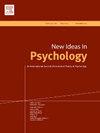Psychiatrization in Czech lexical data: Everyday adjectives are acquiring clinical connotations
IF 2.9
3区 心理学
Q2 PSYCHOLOGY, EXPERIMENTAL
引用次数: 0
Abstract
Interpreting ordinary experiences as symptoms of psychopathology may bias epidemiological numbers and undermine public mental health. Several studies document linguistic shifts underlying psychiatrization in English, but data from other languages are lacking. The current study hypothesizes that psychiatric terminology is increasingly used in everyday, non-clinical contexts while everyday adjectives describing normative mental states and traits are acquiring clinical connotations.
In an exploratory study utilizing computational linguistics, fragments of texts containing diagnostic (e.g. “ADHD” or “anorexia”), everyday psychological (e.g. “shy” or “sad”), or control keywords (e.g. “large” or “loud”) were retrieved from a large (>4bn words) corpus of Czech journalistic texts published offline between 1990 and 2022. A linguistic marker of the cultural aspects of psychiatrization was developed: clinicalness, calculated as lexical proximity to the clinical discourse using the wordscores algorithm. The expected correlation between time and clinicalness was measured by Kendall's coefficient for each of 46 keywords.
The frequency of use of diagnostic terms has been increasing in the Czech press between 1990 and 2022 (for the median keyword: τ = 0.74). The clinicaliness was increasing for everyday adjectives describing human emotions and behaviors (median τ = 0.07) and less so control adjectives (median τ = 0.03), but not in diagnostic terms (median τ = 0.01).
Our exploratory linguistic data are consistent with the notion of increasing psychiatrization of ordinary experiences but not with normalization of mental disorders. Confirmatory research is needed to verify the observed increase in pathologization of everyday adjectives describing emotions and behaviors.
捷克语词汇资料中的精神病学:日常形容词正在获得临床内涵
将普通经历解释为精神病理症状可能会影响流行病学数据,损害公众心理健康。一些研究记录了英语中精神病学背后的语言变化,但缺乏其他语言的数据。目前的研究假设,精神病学术语越来越多地用于日常,非临床背景,而日常形容词描述规范的精神状态和特征正在获得临床内涵。在一项利用计算语言学的探索性研究中,从1990年至2022年间离线发布的捷克新闻文本的大型(>; 40亿字)语料库中检索了包含诊断性(例如“多动症”或“厌食症”)、日常心理(例如“害羞”或“悲伤”)或控制关键词(例如“大”或“大声”)的文本片段。开发了精神病学文化方面的语言标记:临床性,使用wordscores算法计算为与临床话语的词汇接近度。时间与临床性之间的预期相关性通过对46个关键词的肯德尔系数进行测量。在1990年至2022年期间,捷克新闻界使用诊断术语的频率一直在增加(关键词中位数τ = 0.74)。描述人类情绪和行为的日常形容词的临床性增加(中位数τ = 0.07),对照形容词的临床性增加较少(中位数τ = 0.03),但诊断术语的临床性没有增加(中位数τ = 0.01)。我们的探索性语言数据与增加普通经验的精神化的概念一致,但与精神障碍的正常化不一致。需要验证性研究来验证观察到的描述情绪和行为的日常形容词的病理化的增加。
本文章由计算机程序翻译,如有差异,请以英文原文为准。
求助全文
约1分钟内获得全文
求助全文
来源期刊

New Ideas in Psychology
Multiple-
CiteScore
4.80
自引率
3.80%
发文量
37
期刊介绍:
New Ideas in Psychology is a journal for theoretical psychology in its broadest sense. We are looking for new and seminal ideas, from within Psychology and from other fields that have something to bring to Psychology. We welcome presentations and criticisms of theory, of background metaphysics, and of fundamental issues of method, both empirical and conceptual. We put special emphasis on the need for informed discussion of psychological theories to be interdisciplinary. Empirical papers are accepted at New Ideas in Psychology, but only as long as they focus on conceptual issues and are theoretically creative. We are also open to comments or debate, interviews, and book reviews.
 求助内容:
求助内容: 应助结果提醒方式:
应助结果提醒方式:


